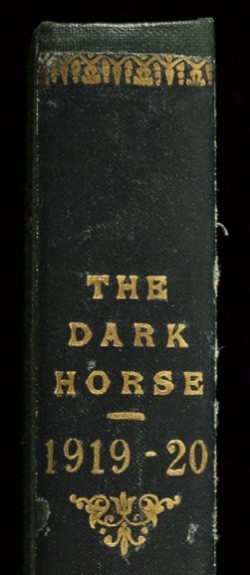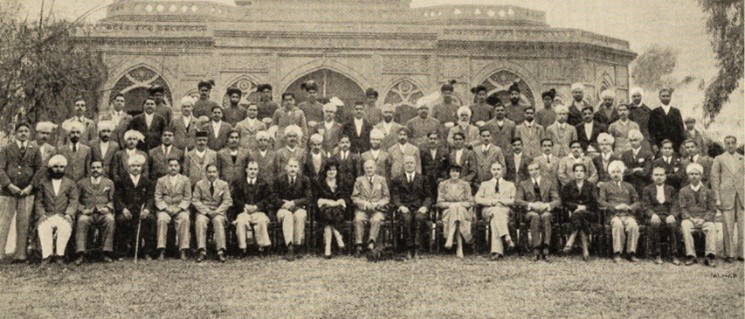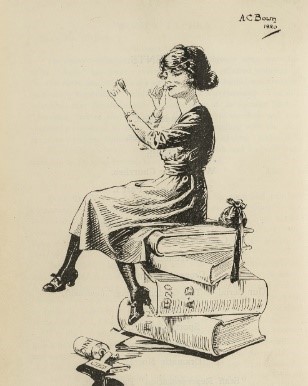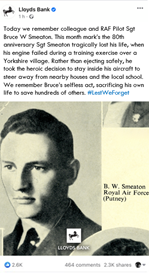Peter Judge is Archivist for the Lloyds Banking Group Archives & Museum

Prior to 2020 at Lloyds Banking Group Archives we had been making plans to digitise parts of our collections. Then, like so many other organisations, we found ourselves in a situation where lockdown restrictions were limiting our access to the archives. Given how much of our work is tied to a physical space, this added extra impetus to our plans for digitisation.
Initially plans were to digitise material that would be made available publicly, i.e. visual material such as branch photographs and advertising, but as a result of the pandemic, conversations shifted toward parts of our collection that would be of benefit to the team. With this in mind we decided to digitise our long-running staff magazine The Dark Horse, to this point a relatively untapped resource.
By working with our vendor, we generated roughly 42,000 images, each of which were OCR-ed and ingested to our digital preservation tool Preservica. This was something of an experiment for us, but the process was surprisingly straightforward and it very quickly became apparent that we had unlocked an incredible resource for social history.
Previously, searching The Dark Horse required looking up specific keywords on our card index (located on a different site to the magazines themselves) or simply jumping into the issues most likely to contain results (checking issues between 1939-1945 to find out what staff were doing during WWII for example). This was often time consuming, and with the lockdown restrictions in place an additional barrier was added as access to the index wasn’t guaranteed. When the entire series was ingested to Preservica, not only was this barrier of physical access broken down, but the volumes’ searchability was improved exponentially – a single search bar is less daunting than several shelves of bound volumes.
 With this vast, newly available resource we have been able to give much richer responses to enquirers both internally and externally. Family history enquiries, for example, now often include anecdotal stories of branch life or pictures, where previously we would have been able to send only the name of the branches they worked at and the length of their employment. The same applies to other topics – the history of branch premises, colleague societies and events, clothes, recipes, fashions, hobbies, living arrangements, wartime precautions, travel abroad and any number of other themes.
With this vast, newly available resource we have been able to give much richer responses to enquirers both internally and externally. Family history enquiries, for example, now often include anecdotal stories of branch life or pictures, where previously we would have been able to send only the name of the branches they worked at and the length of their employment. The same applies to other topics – the history of branch premises, colleague societies and events, clothes, recipes, fashions, hobbies, living arrangements, wartime precautions, travel abroad and any number of other themes.
 One aspect of the project that has been particularly helpful has been around the theme of inclusion and diversity. Increasingly we are being asked for contributions to events like International Women’s Day and Black History Month and with this vast new resource we are constantly finding new and interesting stories to share. We are, for example, able to track the changing opinions towards women in the workplace from early cartoons which show them distracting their male colleagues, right through to stories of the first female branch manager and beyond.
One aspect of the project that has been particularly helpful has been around the theme of inclusion and diversity. Increasingly we are being asked for contributions to events like International Women’s Day and Black History Month and with this vast new resource we are constantly finding new and interesting stories to share. We are, for example, able to track the changing opinions towards women in the workplace from early cartoons which show them distracting their male colleagues, right through to stories of the first female branch manager and beyond.
 This new resource has also allowed us to build relationships with colleagues working in comms, and especially social media. Given the fast pace of the field, we often found it difficult to find content substantial enough for posts. This has completely changed now, and we have found the archives are being used more and more for external posts for major anniversaries or events (VE Day, the Queen’s coronation etc.), or for smaller, quirkier, ad hoc ones (World Animal Day for example). This has introduced a whole new audience to our archive material, with thousands of followers across all the different channels.
This new resource has also allowed us to build relationships with colleagues working in comms, and especially social media. Given the fast pace of the field, we often found it difficult to find content substantial enough for posts. This has completely changed now, and we have found the archives are being used more and more for external posts for major anniversaries or events (VE Day, the Queen’s coronation etc.), or for smaller, quirkier, ad hoc ones (World Animal Day for example). This has introduced a whole new audience to our archive material, with thousands of followers across all the different channels.
Having these magazines digitised has really unlocked their potential as a source of social history. They have made our archive more relatable as the human stories they contain are more accessible than the high-level economic histories our archives have traditionally been used for. The success of this project has also increased our appetite for further digitisation – other brands’ staff magazines, premises photos and more – and I look can’t wait to see the new facets of our collections these will reveal.
